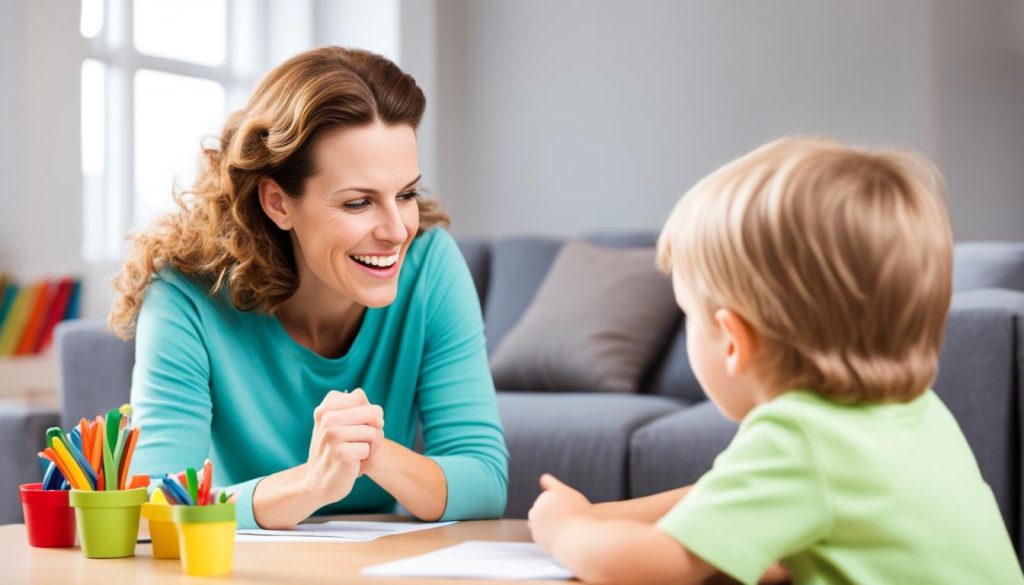Imagine sitting on the porch with your child, feeling the breeze in their hair. They begin to share their day, their stories, and their worries. In these moments, we see how crucial it is to build strong Parent-Child Communication habits. These habits help create a space of openness and trust.
Our talks shape their world, help them grow, and support their mental health. By really listening and engaging, we strengthen our bond. This also helps their emotional well-being and how they connect with others.
Studies show that Positive Parenting, like active listening and safe spaces for sharing, is key to healthy communication. Setting aside distractions and encouraging open talks helps build strong relationships. By spending a few minutes each day in meaningful chats, we create a home where our kids feel heard and valued.
This is more than just talking; it’s about building a lasting bond. This bond supports both of us on our journey together.
Key Takeaways
- Good communication promotes safety, security, and healthy relationships.
- Active listening improves communication and fosters better relationships.
- Dedicated, distraction-free conversation time enhances communication skills.
- Encouraging expression of various feelings aids in emotional and vocabulary development.
- Parents who model respectful communication positively shape children’s behaviors.
Understanding the Basics of Healthy Communication
Healthy communication is key to strong family bonds. By listening and sharing thoughts, you build respect and understanding. This skill is vital for Building Self-Esteem in Children and Encouraging Child Creativity.

The Importance of Active Listening
Active listening is crucial for healthy talks. When you look at your child and ignore distractions, you show them you care about their words. This builds trust and boosts their confidence.
Listen with empathy and repeat back what your child said. This shows you’re really listening. It’s a powerful way to connect.
Expressing Thoughts and Feelings Effectively
Letting kids share their thoughts and feelings is key. Use the right words and tone, and talk about things they can understand. This makes them feel valued and safe to open up.
Ask open-ended questions to keep the conversation going. It shows you’re really interested in what they think.
Here’s some data on how good communication helps:
| Benefit | Outcome |
|---|---|
| Improved Family Relationships | Good communication between parents and children leads to improved relationships within the family. |
| Enhanced Child Cooperation | Parents who communicate well with their kids tend to have more cooperative children. |
| Positive Self-Esteem in Children | When parents talk well with their kids, the kids tend to feel better about themselves. |
Creating a Safe and Supportive Environment
It’s vital to make a safe and supportive space for your kids to talk freely. This space is built on trust, understanding, and clear rules. These rules help teach Family Respect and Empathy. Being there for your kids, knowing what they need, and setting limits are key to a positive home.

Building Trust and Rapport
Trust and rapport are key for good communication between parents and kids. Kids thrive in places where they feel loved and safe. Being a consistent parent helps kids know what’s expected and what happens if they don’t follow the rules. This makes them feel secure.
Studies show that kids who feel loved by their parents grow up happier. They have less depression and anxiety. To build trust, spend quality time with your kids, listen well, and value their thoughts. This strengthens your bond and makes kids feel important and understood.
Establishing Rules for Respectful Communication
Setting limits with kids is important for Family Respect and Empathy. Clear communication rules teach everyone how to talk nicely. Kids from supportive homes get along better with friends and teachers because of what they learn at home.
Doing things together, like eating without screens, makes family bonds stronger and communication better. Being consistent with rules and expectations makes kids trust that they’re treated fairly. This creates a stable and safe place. Teaching empathy at home helps kids think about others’ feelings. This makes for a more caring and understanding home life.
| Aspect | Benefits |
|---|---|
| Trust and Rapport | Promotes security and mutual respect, reduces anxiety and depression among children |
| Respectful Communication | Enhances family respect, empathy, and better peer interactions |
| Structured Parenting | Provides a sense of security, consistent behavior expectations |
| Family Routines | Strengthens family bonds, improves communication |
Active Listening Techniques
Active listening makes communication with kids better by really paying attention to their thoughts and feelings. It makes the parent-child bond stronger by showing you care and are interested. Using good techniques helps create a healthy way to talk to each other.
Body Language and Engagement
Body language is key in active listening. Showing you’re engaged with eye contact and nods or smiles is important. It tells your child you’re fully there and care about what they say. This makes them feel more comfortable sharing things with you, building a stronger bond.
Reducing Distractions
It’s important to keep distractions away when listening actively. Cutting down on screen time for both you and your child helps everyone focus better. Choosing to talk face-to-face instead of on screens helps manage screen time well. This makes sure messages are clear and shows your child their thoughts and feelings matter.

Encouraging Paraphrasing and Clarification
Getting your child to repeat back what they heard helps them understand better and take responsibility in talks. When they say it in their own words, it shows they’re really listening and getting the message. This habit teaches them to check they understand, cutting down on misunderstandings.
“Summarizing a child’s words and feelings can show attentive listening and reinforce understanding without passing judgment.” – Carl Rogers
Stick to these methods to build a caring way to talk. By listening actively, you’re not just controlling screen time. You’re also teaching kids how to be responsible in their talks with others.
| Techniques | Benefits |
|---|---|
| Using Eye Contact | Demonstrates attention and interest |
| Minimizing Screen Time | Reduces distractions and improves focus |
| Paraphrasing | Enhances understanding and retention |
Modeling Effective Communication as Parents

As parents, you set the example for your kids in how to talk and listen. When you give them your full attention and avoid distractions, they learn to respect and engage with others. Studies show kids of attentive parents are more likely to be respectful and listen well themselves.
Effective discipline strategies are key in teaching kids good communication. Being consistent and calm when correcting them shows them how to deal with disagreements. This builds trust and helps them develop healthy relationships.
It’s also key to let your kids share their thoughts and opinions. This makes them think deeply and be more independent. Talking openly with them strengthens your bond and makes them feel safe to share their feelings and ideas. You can learn more about talking about tough topics with your child to improve this.
Role modeling is important from the start to the teenage years. Kids watch how we act, so showing respect, forgiveness, and humility is vital. Talking about your mistakes shows empathy and is a strong lesson for your child. This way, you teach by example, not just by fear or reward.
Encouraging Open Dialogue and Empathy
Empathy is key in parenting. It makes sure kids feel heard and understood. Dr. John Gottman found that love isn’t enough; empathy helps kids deal with their feelings. Talking openly and empathizing with kids boosts their emotional smarts, helps them share their feelings, and solves conflicts well.
Teaching Empathy and Perspective-Taking
Empathy is crucial in how parents talk to their kids. It helps parents get their kids’ feelings and talk better, making their bond stronger and helping kids manage their emotions. Teaching kids to be grateful can also teach them to see things from others’ views. People who are empathetic can feel what others are feeling and try to understand and share those feelings, making others feel seen.
Discussing the Impact of Words and Actions
Positive parenting means seeing how words and actions affect kids. Using thoughtful language, staying calm, and being patient helps parents talk empathetically. This helps kids know and handle their feelings better and solve problems on their own. By explaining reasons and feelings, parents show kids that empathy means supporting them through all feelings, not just the easy ones.
| Key Element | Description |
|---|---|
| Empathy | Listening, understanding, and validating children’s emotions |
| Open Dialogue | Facilitates emotional intelligence and conflict resolution |
| Perspective-Taking | Encourages kids to understand and appreciate different viewpoints |
| Positive Reinforcement | Uses reflective language and patience to enhance communication |
Using Positive Reinforcement in Communication
Positive reinforcement is a top way for parents to change their child’s behavior. It makes kids want to share and listen better. It also stops them from hitting or spitting.
When you use positive reinforcement, praise your child when they do well. This helps them learn to talk better over time. Giving them rewards like praise or small treats makes them want to keep being good communicators. This boosts their self-esteem.
Experts say rewards work better than punishments. Using things like sticker charts helps keep the good behavior going. By praising their efforts, you make them more confident and open to talk.
Being consistent with positive reinforcement means ignoring bad behavior. Make sure good actions get rewards. Praising your child when they communicate well will make them want to do it more.
Studies show that positive reinforcement makes homes happier. A mix of praise and helpful advice, 5:1, can make everyone feel better. This is key to positive reinforcement parenting.
- Praise and Recognition
- Sticker Charts
- Token Economy Systems
Here’s a table showing different types of positive reinforcement and their effects:
| Type of Reinforcement | Example | Impact |
|---|---|---|
| Natural | Clapping and Cheering | Immediate and Encouraging |
| Token | Sticker Charts | Visual Tracking and Motivation |
| Social | Praise and Positive Feedback | Builds Self-Esteem in Children |
| Tangible | Extra Privileges | Long-Term Motivation |
Using positive reinforcement in how you talk to your child shapes their social skills. It creates a respectful and open home. This not only helps your child feel good about themselves but also makes your bond stronger. It’s a big part of positive reinforcement parenting.
Handling Miscommunication with Children
Miscommunication with children is a common challenge many parents face. It’s important to handle these misunderstandings well for better relationships and growth. About one-third of parents put too much of themselves into their kids or relive their own childhood through them. This can lead to high expectations and conflicts, especially when kids don’t live up to these ideals.
Handling miscommunication often means using good discipline strategies. These strategies help with behavior issues and fix communication problems.
17 years of experience as a middle school educator has shown a cultural shift where some parents need their children to look exceptional, creating challenges when facing children’s behavior or performance that does not align with this ideal.
To build a good environment, start with talking things out together. Experts suggest starting with kind words and praising good behavior in the ‘problem’ child. This helps create a team effort. Here’s how you can do it:
- Recognize Emotional Triggers: Find out what makes you and your child upset to manage your reactions better.
- Use Effective Discipline Strategies: Use clear communication and right consequences to help your children solve problems.
- Engage in Active Listening: Listen carefully to what your children say and feel without interrupting or judging right away.
Parents who argue a lot without solving their issues might see their kids act out, skip school, fight, or try drugs and alcohol. So, it’s key to handle conflicts well. This can make your relationship with your partner and your kids stronger and more positive.
| Parents’ Approach | Potential Child Outcomes |
|---|---|
| Unresolved Conflicts | Disobedience, School Problems, Substance Use |
| Constructive Conflict Management | Positive Relationships, Emotional Stability |
Dealing with sibling rivalry and other child conflicts means teaching emotional smarts. This skill is key to success. But, many parents didn’t grow up learning about emotional intelligence, which affects how they handle conflicts.
For kids over five, Kids Helpline offers confidential counseling. Adults can get help from relationship counselors to understand and solve conflict causes.
Using these methods can help fix miscommunication. This creates a caring and supportive place for your kids to grow.
The Role of Social Emotional Learning (SEL) in Communication
Social Emotional Learning (SEL) is key to helping kids talk better. By teaching SEL at school and home, you boost your child’s ability to share feelings and solve problems. Starting early helps kids grow emotionally and socially.
Developing Emotional Intelligence in Children
SEL is vital for kids to grow. Programs that bring SEL into daily life work well. Parents are crucial, making SEL programs more effective when they join in.
Books like “The Whole-Brain Child” by Daniel J. Siegel and Tina Payne Bryson help teach kids about feelings.
| Method | Result |
|---|---|
| Parental Involvement in SEL | Enhanced Emotional Intelligence and School Performance |
| SEL Programs at Home | Increased Self-Esteem and Better Mental Health |
| Collaboration with Schools | Improved Communication Skills and Social Interactions |
Building Conflict Resolution Skills
Teaching kids how to solve conflicts is part of SEL. It gives them tools for life. Working with parents helps kids see others’ views and feel empathy.
Platforms like EverydaySpeech offer videos and activities to help kids learn these skills.
Working together with schools is key for consistent SEL teaching. When families and schools share values, they work better together. This helps kids keep good communication habits.
Parenting and Raising Kids Through Effective Communication
Effective communication is key in parenting. It helps kids become self-reliant and responsible. By talking and teaching values, you shape their growth and behavior.
Fostering Independence through Dialogue
The first step in fostering child independence is talking openly. Meaningful conversations make your child feel heard and valued. This approach lets you understand their needs and feelings, making them open about their thoughts and opinions.
Let your kids help make decisions. This boosts their thinking and problem-solving skills. Talking about rules and chores teaches them about compromise and being accountable. It’s important to value their opinions and celebrate their choices.
Teaching Responsibility and Accountability
Teaching kids about responsibility and accountability is key. Setting clear rules helps them control themselves and respect limits. It’s important to praise their achievements and set realistic goals.
When there are misunderstandings, talk calmly and with understanding. This shows them how to communicate well and own up to mistakes. By showing your strengths and flaws, you build trust and a caring space for your kids.
Quality time with your kids and being a good example teach them about responsibility and accountability. Making these values part of your parenting helps them understand and apply them in life.
“The way we talk to our children becomes their inner voice.” – Peggy O’Mara
Praising kids for good behavior helps build a positive feedback system. Teaching them about responsibility and accountability shapes their development and well-being for a long time.
Strategies for Communicating with Multiple Children
Talking to many kids means having one-on-one chats, making sure everyone feels included, and handling things like sibling rivalry. By paying attention to each child, you show you care about their special needs and who they are. This builds trust and helps them open up, making your family life better.
When dealing with sibling fights, it’s important to be fair and listen to everyone. This stops fights from getting worse and teaches kids how to solve problems together. It also helps them understand fairness and each other better.
It’s key to make your family feel like one big team. Have family meetings where everyone can share their thoughts and feelings. This brings everyone closer and helps solve problems together. Make sure to spend special time with each child to strengthen your bond and help them grow independent.
This way, each child feels important and doesn’t feel left out or in competition with others. It’s also important to have clear rules for talking and behaving in your home. Use kind words, set limits, and teach kids to talk respectfully to each other. Focus on rewarding good behavior and teamwork in talking.
By doing these things, you can make a caring space where every child can grow and feel part of a strong family.
FAQ
Why is fostering healthy communication habits with children important?
What is the importance of active listening in communication?
How can children express their thoughts and feelings effectively?
How can you build trust and rapport with your children?
What are some rules for respectful communication?
What are some active listening techniques that can enhance communication?
How can parents model effective communication habits?
How can you encourage open dialogue and empathy in children?
What role does positive reinforcement play in communication?
How should miscommunications with children be handled?
What is the role of Social Emotional Learning (SEL) in communication development?
How does effective communication foster independence in children?
What are some strategies for communicating with multiple children?
This post contains affiliate links. If you click on a link and make a purchase, I may earn a small commission — at no extra cost to you. Thank you for supporting this blog and helping me keep the patterns free! Read the full Affiliate Disclosure & Transparency.
